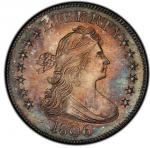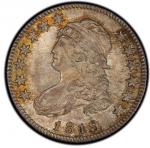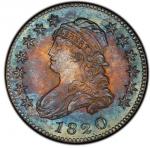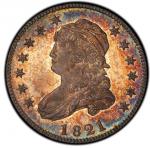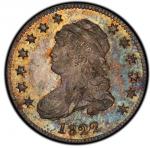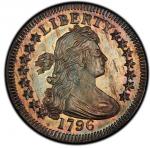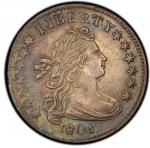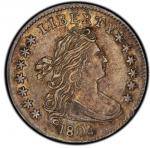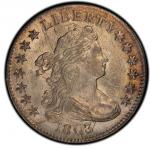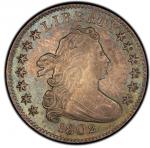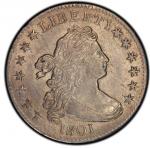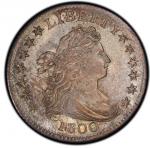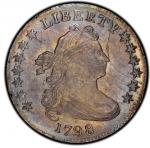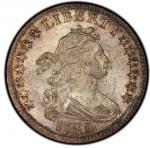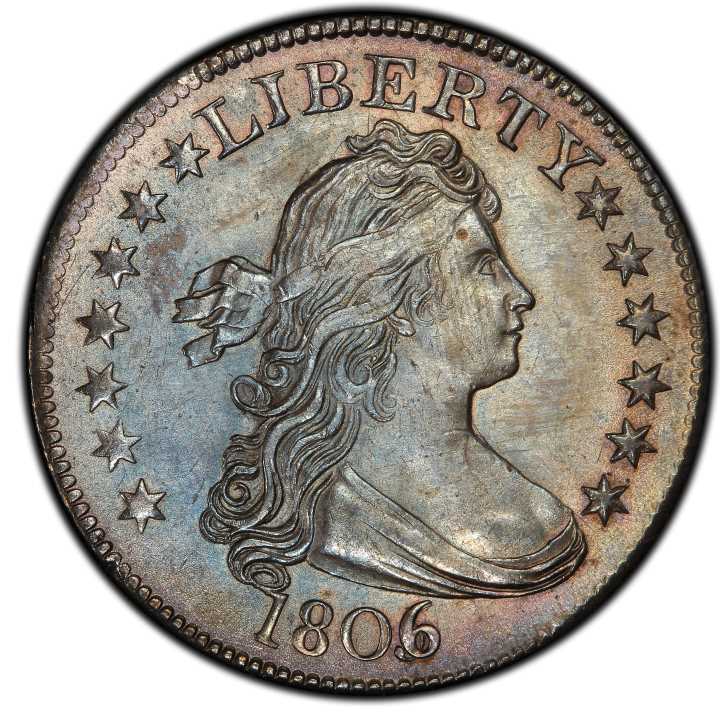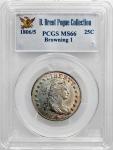The 1827 Quarter is a magnificent piece. I secured it at $215. — Dr. George W. MassamoreThe finest known Original 1827/3/2 quarter, a coin of amazing technical and aesthetic quality, with mirrors and fine details that rival the finest quality the Philadelphia Mint produced decades after 1827. Light gold toning, a bit deeper on reverse than obverse, flavors but fails to cover the deep steel and silver gray of the boldly mirrored surfaces. Strong cameo contrast is present on both sides, perhaps more stark and eye-catching on the reverse than the obverse. Remarkably well struck from a single, solid turn of the screw, showing incredible detail among Libertys curls, the roughened texture of the device punch, the varied and uneven shape of the denticles, and the finest contours of the eagle device. Stars 4, 12, and 13 lack their centers, while the central definition of others range from complete to haphazard. The reverse die is cracked at top, from the rim through ED of UNITED, across the top of the scroll, under F through the bases of A and the centers of ME. The deep mirrored fields and their subtle toning reveal every flaw dramatically, and a glass will find a scattering of the most minor hairlines, the sort that would be invisible on fields of a different texture. A thin curved hairline beneath star 6 touches the forelock, and other fine lines are raised, thus present on the polished face of the die. Spalling, once understood as die rust, is seen in small patches, most prominent behind the eagles head, around C of the denomination, and beneath the final A of AMERICA. The unusual and corroded texture on the bust of Liberty, found on all genuine 1827 quarters, is consistent with an overuse of acid on the face of the die, perhaps used to clean this obverse after four years spent in storage. The overdate is crisp and easy to see, an artifact of this die being re-dated after its initial use for the entire mintage of 1823/2 quarters. In contrast to other overdates, produced by punching over only the final digit, all four digits have been re-punched with current punches, the 1, 8, and 2 being identical to those later used on the quarters of 1828.One of the extraordinary highlights of the D. Brent Pogue Collection, the 1827/3/2 Original quarter was the object of T. Harrison Garretts desire for several years before he finally acquired this example. Its fame was already great before the Civil War, with this variety described as extremely rare in Montroville W. Dickesons 1859 American Numismatical Manual, the first guide written explicitly for collectors of American coins. A newspaper piece had referred to the rarity of 1827 quarters as early as 1857. The first auction appearance for an 1827 quarter appears to have been an 1863 offering for the coin that was later in the Eliasberg Collection, today graded VF-20. Over the following two decades, Garrett had several opportunities to buy an example of this rarity, but he stuck to his stringent requirements for quality. He also rejected overtures to purchase a restrike 1827 quarter, struck in the late 1850s with a mismatched reverse for sale to collectors. Young George Cogan, the son of recently retired Ed Cogan, was disappointed in 1882 when Garrett returned an apparent restrike that he had offered to Garrett for $130, protesting that I sent it to you as it is impossible to obtain an original.Garrett stubbornly stayed the course, insisting upon an original. His opportunity arose in 1884 to acquire not only an original 1827/3/2 quarter, but the very finest known, the coin offered here. He engaged the amiable Baltimore dentist and numismatist Dr. George Massamore to carry his bids to W. Elliot Woodwards sale of the Heman Ely Collection, held in New York in January 1884 in the auction rooms of Bangs, Merwin, and Company, at the intersection of Broadway and Astor Place. Dr. Massamore wrote home immediately after the first session to initially complain that I was obliged to cancel quite a number of your bids on account of overdescription but also to happily report the 1827 quarter is a magnificent piece. I secured it at $215. Since Dr. Massamore sent that missive, this coin has sold at auction exactly once.The 1827/3/2 quarter, like certain other classic American numismatic rarities included in the Pogue Collection, is enigmatic. All were struck as Proofs, but for what purpose is unknown. The nine known Originals, like this one, were clearly struck in 1827, using the same reverse die as the 1828 Browning-1 quarters but in an earlier die state. Their edge reed count of 108 likewise matches the quarters of this era. There is a nice story about Joseph Mickley visiting the Mint in 1827 and securing four Proof quarters for face value, but this twice-told tale seems to have been first published after Mickley died and is likely folklore.This coin held the record for the highest price ever attained at auction by an 1827/3/2 Original quarter until recently. Sold for $190,000 in 1980, no other specimen had brought more until the Gene Gardner Proof-64 (PCGS) sold for $411,250 in 2014. Just as Garrett had to patiently wait to buy a high quality original, so too have contemporary collectors. In fact, the Gardner auction represented just the second opportunity to buy an example of this rarity graded better than Proof-63 since the presently-offered coin was sold at the 1980 Garrett sale. Of the nine specimens that exist, each of which has had its provenance fully traced, just eight are available to collectors. The piece reserved for the Mint Cabinet remains with the rest of the coins collected at the Philadelphia Mint before 1923, now in the National Numismatic Collection at the Smithsonian Institution. Among the eight that remain, one is well worn (the Eliasberg coin, graded VF-20) and most of the others do not approach this coin in terms of technical merits and eye appeal.As noted in the 1980 Garrett sale catalog, for many years the 1827 Original has been considered a landmark in American coinage. Countless comparisons have been made between the 1827 quarter and the 1804 silver dollar (which despite its great fame, actually appears to exist in slightly greater numbers) ... recognized for well over a century as a classic rarity, this piece is one of the most outstanding items offered from the Garrett holdings. So it is today, as this piece is one of the most outstanding items offered from the Pogue Collection, a highlight among the greatest collection of early quarter dollars ever formed.

